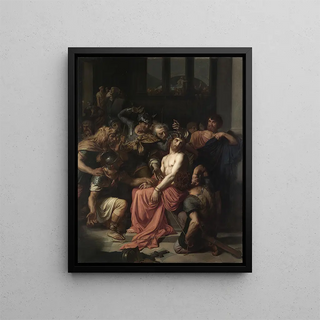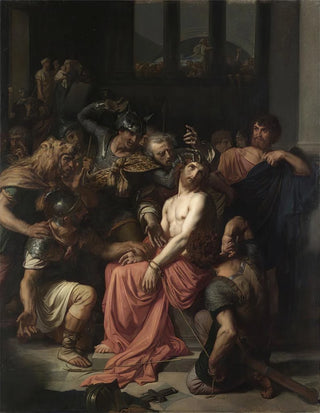Art print | Jesus in the courtroom - Alexandre Cabanel


View from behind

Frame (optional)
The art print "Jésus dans le prétoire" by Alexandre Cabanel embodies a striking encounter between art and spirituality. This piece, created in the 19th century, immerses the viewer in a moment of dramatic tension, where the figure of Christ faces Roman authority. Through vibrant colors and a carefully orchestrated composition, Cabanel manages to capture the very essence of suffering and human dignity. Contemplating this scene, one cannot help but feel a deep empathy for the central character, whose gaze seems to transcend time and space. This work, a true masterpiece of realism, invites us to reflect on universal themes of faith, justice, and redemption.
Style and uniqueness of the work
Cabanel's style is characterized by an exceptional mastery of light and shadow, creating an atmosphere that is both intimate and dramatic. In "Jésus dans le prétoire," the meticulous details of faces, drapery, and expressions highlight the emotional intensity of the scene. The color palette chosen by the artist, oscillating between warm and cool tones, emphasizes the contrast between Christ's serenity and the brutality of his environment. Every element of the composition is carefully thought out to guide the viewer's gaze, immersing them at the heart of the action. Jesus's posture, both humble and resigned, contrasts with the imposing attitude of his accusers, creating a powerful visual dialogue. This play of gazes and gestures makes the work strikingly modern, demonstrating Cabanel's ability to express complex emotions through his painting.
The artist and his influence
Alexandre Cabanel, an emblematic figure of the French academic movement, marked his era with his unique style and his ability to fuse tradition and innovation. Born in 1823, he established himself as one of the most respected artists of his time, influencing many contemporaries and future artists. His training at the École des beaux-arts in Paris and his travels in Italy enriched his work, allowing him to incorporate elements of the Renaissance while developing a personal approach. Cabanel's influence remains significant in the history of art.

Matte finish

View from behind

Frame (optional)
The art print "Jésus dans le prétoire" by Alexandre Cabanel embodies a striking encounter between art and spirituality. This piece, created in the 19th century, immerses the viewer in a moment of dramatic tension, where the figure of Christ faces Roman authority. Through vibrant colors and a carefully orchestrated composition, Cabanel manages to capture the very essence of suffering and human dignity. Contemplating this scene, one cannot help but feel a deep empathy for the central character, whose gaze seems to transcend time and space. This work, a true masterpiece of realism, invites us to reflect on universal themes of faith, justice, and redemption.
Style and uniqueness of the work
Cabanel's style is characterized by an exceptional mastery of light and shadow, creating an atmosphere that is both intimate and dramatic. In "Jésus dans le prétoire," the meticulous details of faces, drapery, and expressions highlight the emotional intensity of the scene. The color palette chosen by the artist, oscillating between warm and cool tones, emphasizes the contrast between Christ's serenity and the brutality of his environment. Every element of the composition is carefully thought out to guide the viewer's gaze, immersing them at the heart of the action. Jesus's posture, both humble and resigned, contrasts with the imposing attitude of his accusers, creating a powerful visual dialogue. This play of gazes and gestures makes the work strikingly modern, demonstrating Cabanel's ability to express complex emotions through his painting.
The artist and his influence
Alexandre Cabanel, an emblematic figure of the French academic movement, marked his era with his unique style and his ability to fuse tradition and innovation. Born in 1823, he established himself as one of the most respected artists of his time, influencing many contemporaries and future artists. His training at the École des beaux-arts in Paris and his travels in Italy enriched his work, allowing him to incorporate elements of the Renaissance while developing a personal approach. Cabanel's influence remains significant in the history of art.






